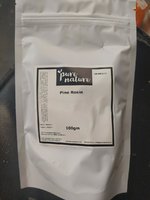Rosin is pine resin after turpentine is removed. So you're basically just painting pine resin on your deadwood. This may be enough to preserve your wood, but whether I would call it a wood hardener or not, I'm not sure. There are tons of after-market wood hardeners on the market depending on what you are trying to do. For extremely rotted or degraded wood that you are trying to stabilize, you will probably get your best results from a two-part thin epoxy - which is designed to penetrate wood fibers before curing, and which you can use with dirty/damp wood. Note however that most epoxies (like polyurethanes and many other products) are not UV stable. Make sure whatever you use is waterproof and designed for exposure to the sun. Also note - if you use wood hardener on visible deadwood you may change the appearance/nature of the deadwood. Make sure you test first (on a dead branch snapped off a tree or something similar) to see if the results are what you are looking for.


